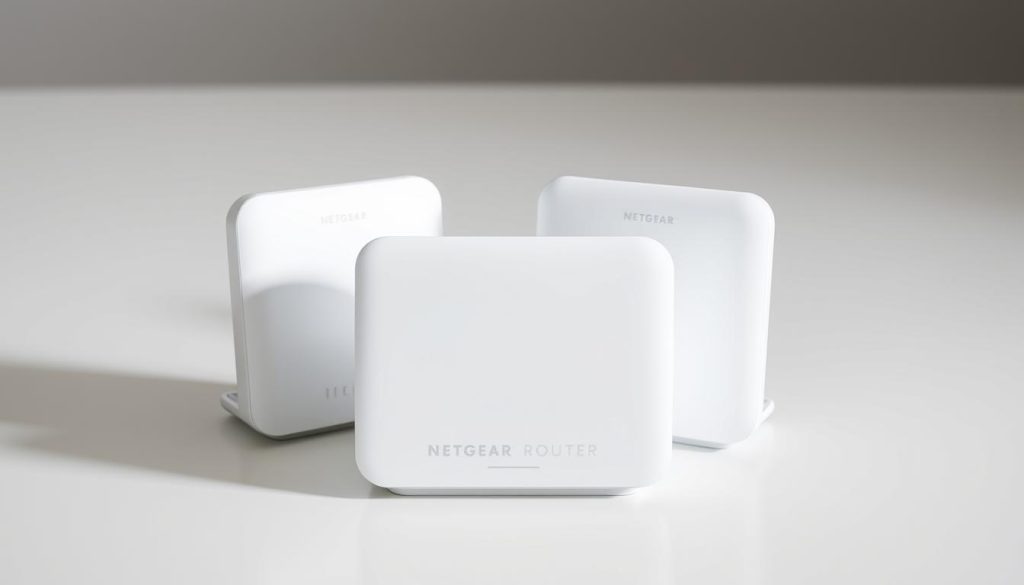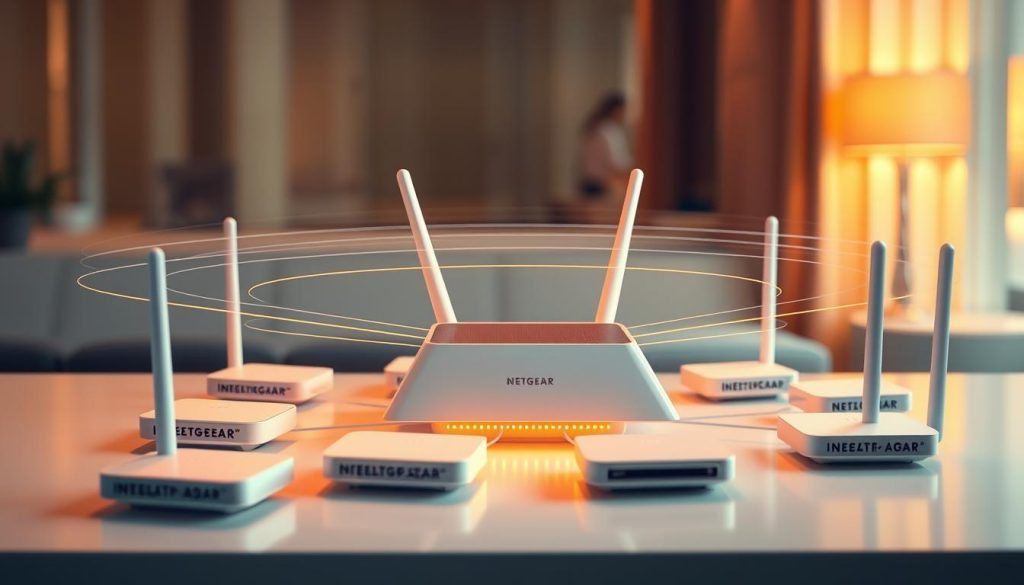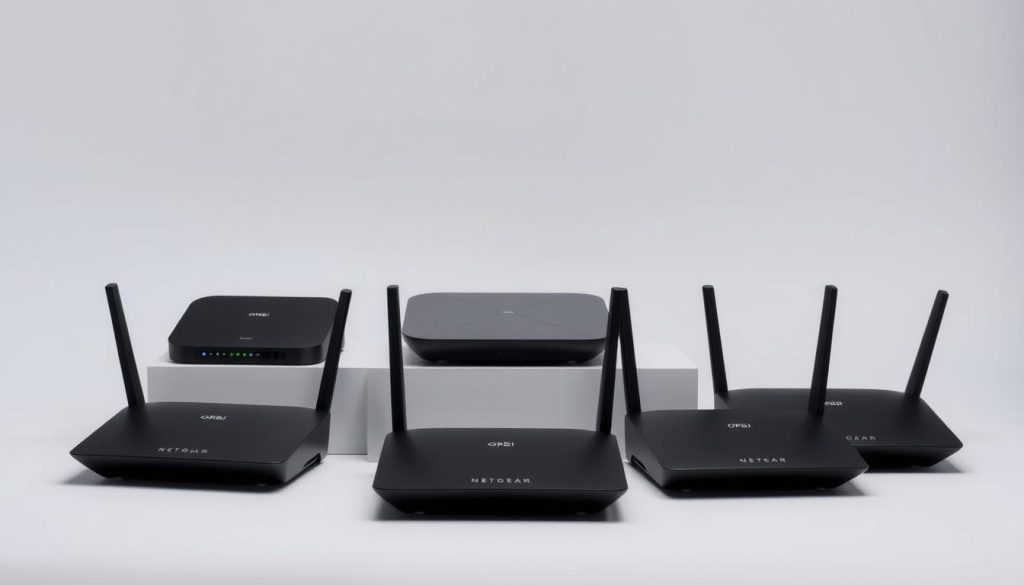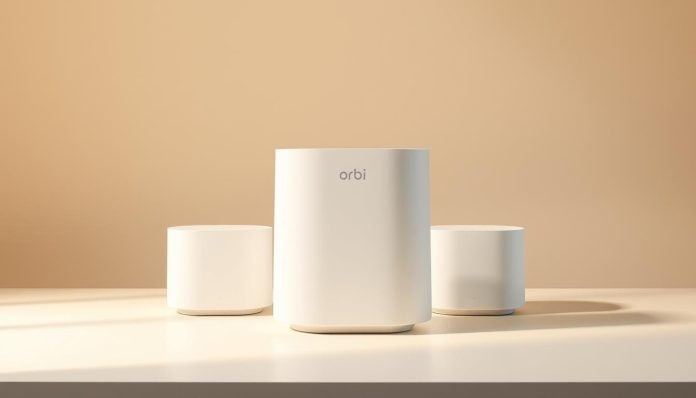You’re shopping for a reliable solution to cover every corner of your home with strong internet and steady performance. This review helps you weigh real-world results, setup time, and cost so you can decide without guesswork.
We tested an AX6000 kit in a 1,300 sq. ft. house on a 300Mbps fiber plan and measured consistent results. Expect average downloads around 367Mbps and uploads near 341Mbps to a modern device, thanks to a tri-band design and a dedicated backhaul.
In this guide you’ll see how a multi-gig WAN port, faster models with a 10Gb option, and one-year security trials affect value. By the end, you’ll know what internet tier and gear match your layout and whether this premium router fits your budget or feels like overkill.
Quick Take: Should You Buy the Orbi Wi‑Fi 6 Mesh Router Today?
For buyers who prize consistent top speeds across many rooms, this option often rises to the top.
At about a $400 list price for a two‑pack, the value depends on your internet plan and expectations. On a 300Mbps service you may not notice much difference versus lower‑cost alternatives.
If your plan is 500Mbps or higher, short‑list this kit for its dedicated tri‑band backhaul and steady real‑world speeds. The app keeps setup quick, and the one‑year security subscription adds peace of mind.
- Choose this kit when you want multi‑gig readiness or wide coverage in a large home.
- Consider Deco W7200, ZenWiFi XD6, or Deco X90 if price is a top concern on sub‑gig plans.
| Model | 2‑pack Price (approx) | Best if your plan |
|---|---|---|
| Orbi AX6000 | $400 | is 500Mbps or higher |
| Deco W7200 | $189 | is 300Mbps or lower |
| ZenWiFi XD6 | $245 | needs solid coverage on a budget |
Netgear Orbi Wi‑Fi 6 Mesh System: Is It Worth the Hype for Secure Home Networks?
For households that mix streaming, smart gadgets, and remote work, a secure backbone matters more than raw headline speed. You get tri‑band hardware paired with centralized software to keep your network steady without constant tuning.
Included protection via netgear armor provides real‑time defenses for connected products during the one‑year subscription. That automated layer scans threats across phones, TVs, and smart devices so you don’t have to micromanage each item.
The app explains what it collects—IP address, device identifiers, inferred behavior, and city‑level location—and lets you opt out during setup. That transparency gives you control over privacy while still using the system’s security features.
- Works with virtually any service provider or modem, so you can bring your own equipment.
- Supports up to 100 devices on the 860 Series, enough headroom for an expanding smart home.
- In‑app parental controls cover basics, but premium features require a paid plan.
Overall, if you want straightforward protection and consistent performance with minimal maintenance, this option delivers a practical balance between convenience and privacy for most homes.
Specs at a Glance: AX6000 Tri‑Band, Dedicated Backhaul, and 10‑Gig Port
A quick look at the hardware numbers tells you what to expect for speed, wired options, and device density.
This AX6000 model delivers up to 6Gbps of aggregate throughput and a 10Gbps port on the main unit for multi‑gig internet plans.
- The tri‑band design includes a dedicated backhaul to keep client traffic separate and preserve performance.
- Four 1GbE LAN ports on both the router and satellite let you hardwire TVs, consoles, and workstations.
- Rated support for up to 100 devices and coverage up to 5,400 sq. ft. from a two‑pack.
Under the hood is a quad‑core 2.2GHz CPU with 1GB RAM and 512MB flash. Patented antenna engineering claims about 20% more range than the prior generation.
| Spec | Value | Why it matters |
|---|---|---|
| Max throughput | Up to 6Gbps | Handles multiple streams and high‑speed plans |
| WAN port | 10Gbps port | Prepares you for multi‑gig service |
| Backhaul | Dedicated 5GHz (4×4 80MHz) | Preserves speed between units |
| Coverage & devices | 5,400 sq. ft. / up to 100 devices | Good for most two‑story homes and smart setups |
Unboxing and Design: What the Router and Satellites Look Like
Right away you see that this kit favors a clean, furniture-friendly look over flashy gamer styling.
You get one router and one satellite in the 2-pack box. The package also includes a 6-foot Ethernet cable, two power adapters, and a Quick Start Guide.
Each unit measures 10″ H x 7.5″ W x 2.8″ D and weighs 2.86 lbs. Finish options are classic white or a black edition, so the pieces fit your home decor.
The design keeps things simple. Both units share the same industrial styling, so they look cohesive when placed on a shelf or side table.
- Four Gigabit LAN ports sit on the back of each unit for easy wiring of nearby devices.
- Ventilation and a solid weight make the product feel durable and ready for long streaming sessions.
- Position satellites about halfway to distant rooms for the best dedicated link and coverage.

| Item | Included | Why it matters |
|---|---|---|
| Box contents | Router, satellite, Ethernet cable, 2 power adapters, guide | Everything needed to start without extra purchases |
| Dimensions & weight | 10″ x 7.5″ x 2.8″, 2.86 lbs | Compact tall chassis fits visible home spots |
| Ports | Four Gigabit LAN per unit | Allows hardwiring of consoles, TVs, and work devices |
| Finish | White or black | Matches room decor and hides wear |
Setup Experience: From App Install to Live Wi‑Fi in Minutes
Setup moves fast: with the companion app you can go from box to a live network in a few simple steps.
On iOS or Android the guided flow takes about 10–15 minutes. You scan the router QR code, name your SSID, and follow prompts to place the satellite. Satellites pair quickly once powered, and the app confirms link quality before you finalize placement.
The interface is nearly as simple as TP‑Link’s Deco app, yet it still offers useful controls. You can pause connectivity per device, schedule downtime, and run in‑app speed tests. Firmware updates appear during install and usually take only a few minutes more.
- Scan QR, create credentials, and run the quick internet test.
- Place satellites midway to far rooms and let the app check signal strength.
- Add devices, set a guest profile, or plug critical gear into LAN ports for stable wired links.
Test room-to-room performance over the first couple of days and tweak placement if needed. The app highlights satellite link quality so you can fine‑tune without guessing. In short, the setup covers the core things most households need to get online fast and stay online reliably at home.
| Stage | Typical time | Why it matters |
|---|---|---|
| App install & QR scan | 2–3 minutes | Gets router recognized and starts provisioning |
| Satellite placement & pairing | 5–8 minutes | Ensures strong dedicated backhaul and coverage |
| Final checks & updates | 3–5 minutes | Applies firmware and confirms internet access |
Performance Testing: Real‑World Speeds and Consistency Across Rooms
Live testing across multiple spots in a 1,300 sq. ft. home reveals how steady performance feels day to day.
On a 300Mbps fiber plan, this AX6000 setup averaged 367Mbps download and 341Mbps upload to a modern client. Those mbps figures translate to smooth streaming video and fast file transfers across most rooms.
Older clients using the previous generation averaged about 289Mbps download. That trails a few competitors on raw numbers but still supports HD streaming and work calls without trouble.
The system stayed consistent regardless of time of day or distance to a satellite. Uploads held steady too, which matters for cloud backup and video conferencing when many devices share the link.

- Room‑to‑room speeds on a 300Mbps plan match or exceed plan limits, reducing buffering.
- Dedicated backhaul helps satellites deliver near‑router speeds in distant rooms.
- On lower‑speed fiber plans (100Mbps) results mirror other top kits because the ISP cap is the limit.
| Client Type | Typical Download | Real‑world Note |
|---|---|---|
| Wi‑Fi 6 device | ~367 Mbps | Best overall performance and consistency |
| Wi‑Fi 5 device | ~289 Mbps | Good, may lag top competing models |
| 100Mbps fiber home | ~100 Mbps | ISP cap limits perceived gains |
Ccoverage and Range: Whole‑Home Mesh Wi‑Fi Without Dead Zones
A well-placed two-piece kit can erase dead zones across most single-family layouts.
Rated for about 5,400 sq. ft., a properly installed 2‑pack should cover living areas, upstairs rooms, and some outdoor spaces. The antenna design claims roughly a 20% boost in overall coverage versus the prior generation.
The dedicated backhaul helps preserve bandwidth as you move from the main unit to a satellite. That keeps performance steady so streaming and calls don’t drop when you roam.
Wall density, floor materials, and interference sources still affect real‑world range. Place units in open, elevated spots and avoid thick masonry or metal obstructions to improve signal spread.
- One 2‑pack: good for most homes up to the rated sq. ft.
- Add a third satellite for long, narrow houses or multiple outbuildings.
- Tri‑band capacity helps the kit serve many devices without stalling.
| Scenario | Expected Result | Action |
|---|---|---|
| Single‑family, ≤5,400 sq. ft. | Full coverage, minimal dead zones | Place satellite midway to distant rooms |
| Large footprint or outbuildings | May need extra satellite | Add 1–2 satellites and test link quality |
| Dense walls / basements | Reduced range and throughput | Use elevated placement and wired backhaul if possible |
Quick tip: Confirm your home’s sq. ft. against the rating before buying. Proper placement matters more than peak speed when you want consistent coverage across every room.
Backhaul Matters: Why Orbi’s Tri‑Band Dedicated Backhaul Stays Fast
A dedicated link between base and satellite keeps heavy traffic off client channels and preserves throughput at range.

That reserved 5GHz 4×4 (80MHz) radio handles only inter‑node traffic. By isolating that chatter, your client devices keep full access to the other bands. This reduces contention and keeps real‑world speeds steadier across rooms.
In practice, the separation means router satellites relay data without stealing airtime from phones, laptops, or streaming boxes. Dual‑band kits must share channels, so they can slow when many devices compete.
- You keep higher throughput at the edge of your home even during peak use.
- Cleaner airtime between units cuts interference and eases roaming handoffs.
- Better backhaul translates to more reliable connections when many devices are active.
| Feature | Benefit | Why it matters |
|---|---|---|
| Tri‑band reserved backhaul | Cleaner inter‑node links | Maintains high speeds across the mesh system |
| 5GHz 4×4 (80MHz) | High capacity between units | Reduces congestion on client bands |
| Dedicated radio | Smoother roaming | Improves overall network stability in multi‑story homes |
Multi‑Gig Ready: Future‑Proofing with 10‑Gig and 2.5Gb Support
A 10‑Gig WAN port changes how you plan wired and wireless gear in a high‑speed home.
This 860 Series adds a 10gbps WAN port for internet, while earlier AX6000 models capped at 2.5gbps. That higher max removes a common bottleneck as neighborhood services roll out faster tiers.
In practice, a faster WAN port keeps your plan from being limited by the router when you upgrade. ISPs such as Comcast Xfinity, Verizon, Google Fiber, Ziply Fiber, and AT&T are expanding multi‑gig services in many areas.
- Use the four 1GbE LAN ports on each unit to hardwire a desktop, NAS, or gaming console for low latency.
- Combine wired LAN and dedicated backhaul to protect your max throughput as you add high‑bandwidth devices.
- Check your internal switches and cabling so your home can actually benefit from a faster internet line.
| Feature | Value | Why it matters |
|---|---|---|
| WAN | 10Gbps (860 Series) | Prepares you for multi‑gig service tiers |
| Previous WAN | Up to 2.5Gbps | Limits upgrades above 2.5Gbps without replacement |
| LAN | Four 1GbE per unit | Stable wired links for key devices |
Security and Privacy: NETGEAR Armor, Parental Controls, and Data Practices
Built-in protections can save time and reduce the number of paid subscriptions you manage for each gadget.
The kit includes a one-year netgear armor subscription that provides real-time protection across phones, laptops, TVs, and security cameras. That layer can also add VPN-style features to shield outbound traffic from basic threats.
Smart Parental Controls handle time limits and content filters, though advanced rules require a paid premium plan. You can use guest access to isolate visitor devices and IoT products from more sensitive household gear.
| Feature | What it does | Action |
|---|---|---|
| netgear armor (1‑yr) | Device-level threat detection | Enable by default; review alerts |
| Parental controls | Time limits, filters | Use free basics; upgrade for advanced filters |
| Data controls | App disclosures and deletion tools | Opt out at setup; request deletion online |
The companion app discloses that it may collect your IP address, device identifiers, and inferred behavior. You can opt out during setup and use online forms to request access or deletion. The manufacturer says it does not share user data with third parties for independent marketing.
Keep firmware auto‑updates on, use unique passwords and enable two‑factor authentication where possible. These simple steps improve protection while keeping security convenient and manageable for everyday things you do online.
Who Will Notice the Speed: Matching Your Internet Plan to Orbi’s Potential
Deciding whether you’ll notice faster performance starts with matching your service plan to the hardware’s ceiling. If your monthly tier is 500Mbps or higher, you’re likely to see a clear advantage.
On 200–300Mbps tiers, measured speeds still feel solid, but lower‑cost alternatives may match day‑to‑day responsiveness. In a 100Mbps household, many kits hit the ISP cap and feel similar.
You should weigh how many people stream, game, or run video calls at once. Those activities push simultaneous load and reveal the router’s value when your internet plan has enough headroom.
- If you want future proofing, plan for multi‑gig only if you may need it within 12–24 months.
- Consistency often matters more than chasing the last 50 mbps in tests.
- Placement, interference, and backhaul affect perceived wifi speed as much as your ISP tier.
| Service tier | What you’ll notice | Action |
|---|---|---|
| ≥500 Mbps | Real gains across many devices | Consider premium kit and 10Gb WAN |
| 200–300 Mbps | Good daily performance; competitors close | Match satellites to house size |
| 100 Mbps | Nearly identical results across kits | Focus on placement, not raw hardware |
Match your choice to household size and future plans so your home handles peak usage without overbuying. That way you get the right balance between cost and the things you actually need.
Alternatives Worth a Look: Comparable Mesh Routers at Lower Prices
If you want similar day‑to‑day performance without paying premium prices, several rival kits deserve a look.
TP‑Link Deco W7200 ($189 for a 2‑pack), Asus ZenWiFi XD6 ($245), and TP‑Link Deco X90 ($280) all hit downloads above 300Mbps in our 1,300 sq. ft. test home. That means on a 300Mbps plan you may not notice real differences in everyday use.
Older value options such as Eero 6, Asus ZenWiFi Mini, Motorola MH7603, and Nest Wifi (Wi‑Fi 5) cost less and suit modest needs or small homes.

Consider total cost versus perceived benefit, firmware updates, warranty, and app quality when choosing. If you plan to upgrade service soon, premium hardware may pay off. If not, a lower‑cost product will likely meet your needs.
| Model | 2‑pack Price | Real‑world performance | Best use |
|---|---|---|---|
| TP‑Link Deco W7200 | $189 | ~300+ Mbps in 1,300 sq. ft. | Budget multi‑room coverage |
| Asus ZenWiFi XD6 | $245 | ~300+ Mbps, stable roaming | Small‑to‑medium homes |
| TP‑Link Deco X90 | $280 | ~300+ Mbps, higher radios | More devices, future headroom |
Ports and Wired Options: LAN Density, Console/TV, and Workstation Needs
Wired ports turn a strong router into a flexible hub for living‑room media, workstations, and storage.
The main unit includes one 10Gbps WAN port and four 1GbE LAN ports. The satellite also offers four 1GbE LAN ports. That layout lets you place wired connections where they make the most sense in your home.
Wire stationary devices like a gaming console or TV to a satellite for lowest latency and steady streams. Use the router’s LAN ports for a desktop or NAS to avoid saturating wireless links when moving large files.
- Offload heavy hitters to Ethernet so wireless clients keep max available capacity.
- Add a small unmanaged switch at your entertainment center to expand ports cheaply.
- Keep competitive gaming or live broadcasting on Ethernet to minimize jitter.
- Use Ethernet backhaul if practical, though the dedicated wireless backhaul already preserves capacity well.
Confirm cable quality (Cat5e or better) so you don’t cap speeds below your gbps WAN limit. Plan router and satellite placement near clusters of wired devices to keep connections neat and efficient.
| Port Type | Where to Use | Benefit |
|---|---|---|
| 10Gbps WAN | Internet uplink | Prevents ISP bottleneck at max plan |
| 1GbE LAN (router) | Desktop, NAS | Stable transfers, low latency |
| 1GbE LAN (satellite) | TV, console | Reliable streaming near devices |
Build a hybrid network: wired stability where it counts and wireless flexibility everywhere else.
Satellite Strategy: How Many You May Need for Your Sq. Ft. and Yard
Map rooms and obstructions before buying extra satellites to avoid costly trial-and-error. A 2‑pack covers up to 5,400 sq. ft., with each satellite adding roughly 2,700 sq. ft. in ideal conditions.
Place a satellite about halfway to distant rooms so it keeps a strong link back to the router. Too close wastes capacity; too far drops throughput and harms range.
Use the app to check link quality after you place a satellite. Move it a few feet at a time until the dedicated backhaul shows a strong status.
- Match your floor plan to decide if one satellite is enough or if a second covers far wings or an outbuilding.
- Factor in brick, concrete, or metal walls that reduce signal and call for denser placement.
- Pick open, central spots on shelves or tables and plan for nearby power outlets to keep installs tidy.
| Scenario | Action | Why it matters |
|---|---|---|
| Up to 2,700 sq. ft. | One satellite | Good coverage for a compact home |
| 2,700–5,400 sq. ft. | Two satellites (2‑pack) | Full yard and upstairs reach |
| Detached garage or deep basement | Add a second satellite | Extends range to outbuildings and weak rooms |
Test critical rooms after setup and scale your mesh to match real needs. That way you avoid overspending while keeping steady coverage where you live and work.
Price, Warranty, and Value: Is the Premium Cost Justified?
When you compare list prices and real‑world gains, value becomes more than a sticker number. Historic pricing puts a typical 2‑pack near $400, though seasonal sales often bring that down for a few days.
You should weigh the product’s higher cost against consistency and multi‑gig readiness that can outlast cheaper options. The kit includes a one‑year security subscription that offsets third‑party costs during year one.
- Consider alternatives priced $189–$280 if your internet plan is 300Mbps or lower.
- Factor in a one‑year limited warranty and 90‑day complimentary tech support from authorized sellers.
- Account for ongoing expenses if you extend protection or parental features after included trials.
| Feature | Value | Why it matters |
|---|---|---|
| Historic price | $400 (2‑pack) | Sets baseline for comparison |
| Alternatives | $189–$280 | Lower cost, similar daily performance on mid tiers |
| Warranty & support | 1 year / 90 days | Covers early firmware cycles and setup help |
Weigh resale value and longevity if you plan to keep gear for years. Think about opportunity cost: on some plans you pay for headroom you won’t use for months. Decide if that future proofing matters more than saving now.
Pros and Cons: What You’ll Love and What May Frustrate You
You’ll see fast, steady performance every day, which makes streaming, calls, and file transfers feel reliable across rooms.
Setup is simple, and you get a full year of built-in Armor protection for your devices right out of the box. The 10Gb internet port and tri‑band design help preserve speeds as your plan and device count grow.
- You’ll love the day‑to‑day consistency across rooms that makes your home internet feel faster and more reliable.
- You’ll appreciate the quick setup and minimal maintenance, plus security coverage for devices included for a year.
- You’ll like the forward‑looking 10Gb port and tri‑band layout that protect performance as demands rise.
- You may be frustrated by the higher price compared with budget routers and meshes that match real‑world results on modest plans.
- You might want deeper advanced controls for gamers or power users, which this kit does not emphasize.
| Pros | Cons | Best fit |
|---|---|---|
| Fast, consistent performance | Higher cost vs alternatives | Large homes, many devices |
| Excellent coverage and wired LANs | Limited advanced power‑user features | Users who value simple, reliable setup |
| 10Gb WAN on 860 Series | Less benefit under ~500 Mbps plans | Future‑proof households planning upgrades |
Conclusion
In short, choose gear that fits your plan, device count, and how much range you need. The AX6000 led tests with about 367 Mbps on a 300 Mbps fiber line and proved steady across rooms.
You get a 10 Gb WAN port, up to 6 Gbps aggregate, coverage near 5,400 sq. ft., and room for roughly 100 devices. Setup takes about 10–15 minutes via the app, and a one‑year security trial plus a one‑year warranty add value.
If your plan and devices can use the extra headroom, this mesh system and mesh router deliver consistent wifi speed and smoother streaming video. If not, lower‑cost options can match real‑world mbps on modest plans.
Final word: pick based on how you’ll actually use the network — upgrade when your needs and service provider make the fastest speeds worthwhile.

